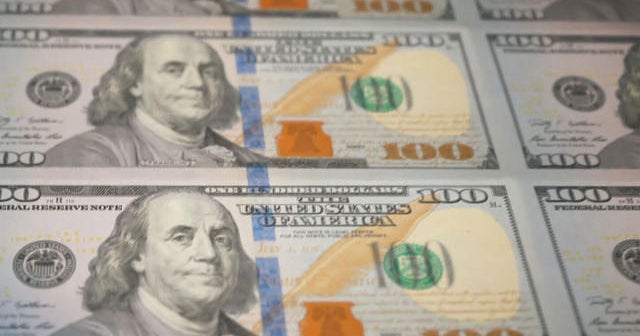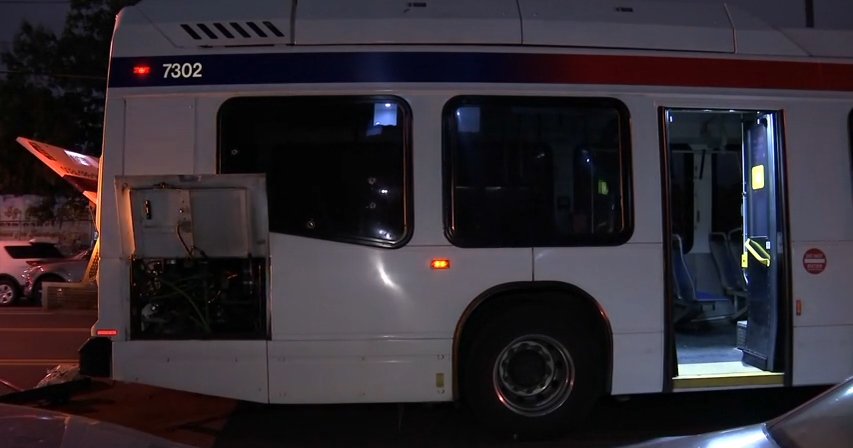CBS News
Credit card maxed out? Here are 3 things to do (and 3 to avoid)

Getty Images/iStockphoto
Issues with credit card accounts have been compounding recently as more Americans struggle to keep up with high inflation and soaring interest rates. For example, the credit card delinquency rate jumped to nearly 9% during the first quarter of 2024. And, recent data shows that many cardholders — and members of Gen Z in particular — are now facing issues with maxed-out credit card accounts, too.
Part of the issue is that the current high inflationary environment is putting a strain on household budgets, with the latest inflation report showing that prices for essential goods and services are rising at a pace of 3.4%. At the same time, the Federal Reserve has held interest rates at a 23-year high over the last several months in an effort to tame inflation, which has pushed the average credit card interest rate to over 21%. This potent combination of higher costs and borrowing rates is causing many people’s finances to become stretched.
Having a maxed-out credit card or two is not only stressful in many cases, but it can also have a tangible impact on your finances. That’s because when your credit utilization is high, it can negatively affect your credit score, making it harder and more expensive to borrow money in the future. And, the compounding interest charges on a maxed-out card can quickly spiral out of control, making it even more difficult to pay off the debt. Fortunately, there are a few moves you can make (and a few you should avoid) if you’re dealing with this issue.
Compare your debt relief options and find out what help is available to you here.
Credit card maxed out? Here are 3 things to do
If you find yourself in the unfortunate situation of having a maxed-out credit card, it’s important to take action. Here are a few things you may want to do if you’re dealing with this issue:
Inquire about credit card hardship programs
During times of financial hardship, many major credit card issuers offer relief programs to customers that can provide some breathing room in terms of your payments. These programs may allow you to temporarily reduce or suspend your minimum payments, waive late fees or even reduce your interest rate for a period of time.
Reaching out to your card issuer and explaining your situation is often the first step to accessing these hardship programs. You may also have to provide documentation related to the specific hardship you’re facing, whether it’s a short-term issue like a job loss or a chronic medical condition that’s impacting your finances. But that can be a small sacrifice to make if the result is paying less on your credit card debt, even temporarily.
Explore how the right debt relief company could help you tackle your credit card debt.
Talk to a debt relief company
If you’re dealing with overwhelming credit card debt across multiple accounts, you may want to talk to a debt relief company about the options it can provide, which may include:
- Debt consolidation programs: With a debt consolidation program, the debt relief company seeks to consolidate your various credit card debts into a single, new loan with a lower interest rate than you’re currently paying. This simplifies your monthly payments into one bill, ideally with a lower total payment than you were making across all your different cards.
- Debt management plans: With this option, you deposit a single monthly payment with the debt relief company, which then disburses payments to each of your creditors on your behalf. In many cases, the debt relief company has negotiated lower interest rates and fees with lenders specifically for customers enrolled in these debt management plans. The convenience of making just one payment is a perk to utilizing this type of program, as is the potential interest rate reductions.
- Debt settlement programs: With a debt settlement program, you make monthly payments into an escrow-like account with the debt relief company. Once a sufficient balance has accumulated, the company attempts to negotiate lump sum settlements with each of your creditors for less than you owe. Settled debts are paid off from your escrow funds. The major downside is that your credit score will take a major hit, as the settled debts are reported as “settled for less than agreed.” Settled debt may also be considered taxable income by the IRS.
It’s also worth noting that debt relief companies typically charge fees for their services. And it’s crucial to thoroughly vet any debt relief company before enrolling to ensure they are legitimate and that you understand exactly what services they provide and are aware of all fees involved.
Take a measured DIY approach to paying off what you owe
If your income situation allows you to continue making minimum payments on your maxed-out cards, consider implementing a strategy like the debt snowball or debt avalanche method. Both strategies can provide a psychological boost and help you make meaningful progress on paying down your debts.
With the snowball approach, you focus on paying off your smallest debt first while making minimum payments on the others. Once the smallest debt is repaid, you roll the money from that payment onto the next largest debt once the first is paid off. The avalanche method works similarly, but it prioritizes paying off the debt with the highest interest rate first.
And, while focusing on getting existing debts under control should be the top priority when your cards are maxed out, increasing your income could also be considered. This can be done through a temporary side gig, freelance work or a career change, but whatever the approach, the goal is to find extra funds to throw at your credit card balances.
3 things to avoid if your credit cards are maxed out
There are also some actions you should avoid if your credit cards are maxed out, as they can potentially make the situation worse. These include:
Ignore the issue
If you’re overwhelmed by your credit card debt, it may be tempting to simply ignore the issue and stop making payments on your maxed-out card, but this will only lead to late fees, penalty APRs and potentially even legal action from your creditors. Ignoring the problem will not make it go away and can severely damage your credit score in the interim.
Continue taking on more debt
While it may seem like a quick fix, taking out personal loans or opening new credit cards to pay off or transfer the balance from a maxed-out card is often a recipe for disaster. This approach can lead to a vicious cycle of debt that becomes increasingly difficult to escape, so try to avoid it if you can.
Immediately consider bankruptcy
While bankruptcy may be a viable option for some borrowers who are in severe financial distress, it should be an absolute last resort to consider in most cases. After all, bankruptcy can have long-lasting negative impacts on your credit score and ability to borrow money in the future — and it’s the most drastic approach you can take to your credit card debt. So, in most cases, you should try to exhaust all other options before considering this measure.
The bottom line
Having a maxed-out credit card is a stressful and potentially damaging situation, but it’s important to take a proactive approach to resolve the issue. While it may be tempting to ignore the problem or take on more debt to make ends meet, these approaches can often make the situation worse in the long run. Try exploring options like hardship programs, debt relief strategies and increasing your income instead. After all, with discipline and a solid plan, it is often possible to dig yourself out of a maxed-out credit card hole.
CBS News
Former New York Gov. David Paterson, stepson attacked while walking in New York City

NEW YORK — Former New York Gov. David Paterson and his stepson were attacked in New York City on Friday night, authorities said.
The incident occurred just before 9 p.m. on Second Avenue near East 96th Street on the Upper East Side, according to the New York City Police Department.
Police said officers were sent to the scene after an assault was reported. When officers arrived, police say they found a 20-year-old man suffering from facial injuries and a 70-year-old man who had head pain. Both victims were taken to a local hospital in stable condition.
In a statement, a spokesperson for the former governor said the two were attacked while “taking a walk around the block near their home by some individuals that had a previous interaction with his stepson.”
The spokesperson said that they were injured “but were able to fight off their attackers.”
Both were taken to Cornell Hospital “as a precaution,” he added.
Police said no arrests have been made and the investigation is ongoing.
The 70-year-old Paterson, a Democrat, served as governor from 2008 to 2010, stepping into the post after the resignation of Eliot Spitzer following his prostitution scandal. He made history at the time as the state’s first-ever Black and legally blind governor.
CBS News
10/4: CBS Evening News – CBS News

Watch CBS News
Be the first to know
Get browser notifications for breaking news, live events, and exclusive reporting.
CBS News
Teen critically wounded in shooting on Philadelphia bus; one person in custody

A 17-year-old boy was critically injured and a person is in custody after a gunman opened fire on a SEPTA bus in North Philadelphia Friday evening, police said.
At around 6:15 p.m., Philadelphia police were notified about a shooting on a SEPTA bus traveling on Allegheny Avenue near 3rd and 4th streets in North Philadelphia, Inspector D F Pace told CBS News Philadelphia.
There were an estimated 30 people on the bus at the time of the shooting, Pace said, but only the 17-year-old boy was believed to have been shot. Investigators said they believe it was a targeted attack on the teenager and that he was shot in the back of the bus at close range.
According to Pace, the SEPTA bus driver alerted a control center about the shooting, which then relayed the message to Philadelphia police, who responded to the scene shortly.
Officers arrived at the scene and found at least one spent shell casing and blood on the bus, but no shooting victim, Pace said. Investigators later discovered the 17-year-old had been taken to Temple University Hospital where he is said to be in critical condition, according to police.
CBS Philadelphia
Through their preliminary investigation, police learned those involved in the SEPTA shooting may have fled in a silver-colored Kia.
Authorities then found a car matching the description of the Kia speeding in the area and a pursuit began, Pace said. Police got help from a PPD helicopter as they followed the Kia, which ended up crashing at 5th and Greenwood streets in East Mount Airy. Pace said the Kia crashed into a parked car.
The driver of the crashed car ran away but police were still able to take them into custody, Pace said.
Investigators believe there was a second person involved in the shooting who ran from the car before it crashed. Police said they believe this person escaped near Allegheny Avenue and 4th Street, leaving a coat behind.
According to Pace, police also found a gun and a group of spent shell casings believed to be involved in the shooting in the same area.
“It’s very possible that there may have been a shooting inside the bus and also shots fired from outside of the bus toward the bus,” Pace said, “We’re still trying to piece all that together at this time.”
This is an active investigation and police are reviewing surveillance footage from the SEPTA bus.



